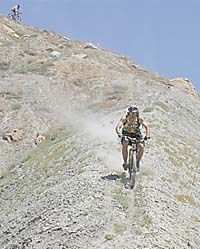| Knowing the techniques for going down hill are important to avoid crashes and injuries when trail riding. |
In every sport technique can make the difference between winning and losing, enjoyment and misery, safety and accidents.
For mountain bikers it is always good to remember to ride within limits. It is better to get off and walk an area that isn’t comfortable, than to risk injury.
•Balance. Balance is crucial in mountain biking, not just left-right balance, but front to back balance. Weight over the rear wheel is what gives traction: if the back tire is slipping, try moving back on the seat, or if standing, transfer more weight to the rear of the bike. If the front wheel comes off the ground, then you need to transfer more weight to it.
•Climbing. Most riders will do at least some of their hardest climbs out of the saddle. It is necessary to rock the bike gently with each pedal stroke in order to keep the bike in a straight line. As the right pedal goes down, rock to the right, as the left pedal goes down, rock to the left, and so on.
•Descending. Stay back on the bike. On steep descents, the rider may have to be behind the seat. Use the brakes before corners, not in them. Don’t descend unsure areas. Walk the bike if in doubt.
•Cornering. Learn the technique of “counter steering”. Brake before corners, not in them. Riders should look where they want to go, not at what you don’t want to hit. Bikes have a way of going wherever the rider looks. Slow down to a safe speed, then accelerate out of corners. Don’t skid, it looks fast, but it isn’t. Lean into turns; “lead” with the inside knee to help with this.
•Braking. Most of the braking force is in the front brake. Use both brakes simultaneously, and brake before corners, not in them. Do not lock up back brakes to skid! It is destructive to the trail, and not as effective at slowing down the bike.
•Shifting. Always pick a gear that allows the rider to “spin” their pedals at between 60 and 90 rpm. Try counting the revolutions for 10 seconds, then multiply by it by six, or get a cyclometer with a cadence (RPM) function. Different shifters work differently, so get someone in the know to explain how they work. Lower gears are “easier” to spin on hills, while higher gears are “harder”. The smallest chain ring (on the crankset, where the pedals are) is the lowest gear range, while the largest chainring is the highest gear range. The largest cog on the freewheel (on the back wheel) is the lowest gear, while the smallest cog is the highest gear. It is the combination of the chain ring (gear range) and cog (gear) that gives the overall gear ratio the bike is in. Try shifting to a lower gear before being in the middle of a steep hill.
•Singletrack. On these narrow trails, don’t look off the trail, instead focus on the trail ahead. Slow down around blind curves; other riders, hikers or equestrians may be around the corner.
Mud. It is best to just not ride in mud. It leaves deep groves which water follows, causing erosion. When hitting a small patch of mud on an otherwise dry trail, pull up lightly on the bars, and either maintain speed or pedal through. If the mud is deep, walk the bike around it. Do not try to ride around – this causes the trails to get widened beyond what they were originally intended.
•Sand. This is similar to mud, but try a slightly higher gear than would be normally ridden in.
•Rocks, holes, and bumps. When going over rocks, holes, or bumps that may trap the front wheel, move the weight back so that the wheel can “float” over the obstacle. Sometimes the rider will need to pick up the front wheel (called “lofting”) to get it over the obstacle. The rear wheel will often just roll through the obstacle.
•Water and water crossings. Avoid riding through streams where possible; a tire’s passage causes sedimentation of the stream. If a stream must be crossed maintain momentum in a low gear, and use a light touch on the handlebars. Let rocks deflect the tire gently.
While technique takes some learning a lot of it is just common sense.
Use it.

